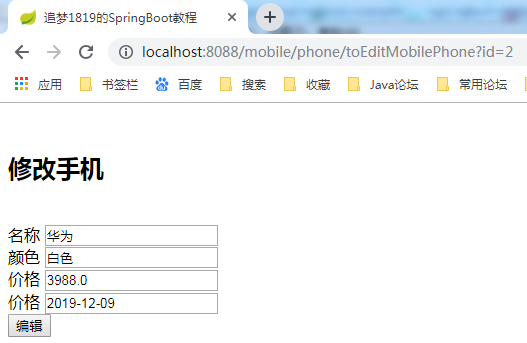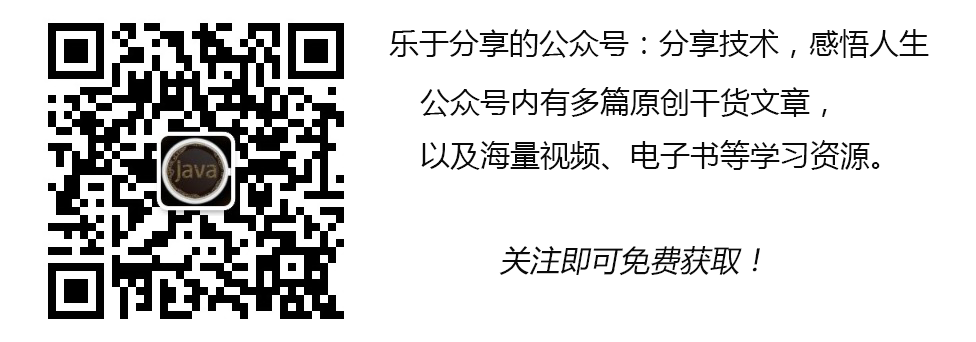SpringBoot第十一篇:SpringBoot+MyBatis+Thymelaf实现CRUD
作者:追梦1819
原文:https://www.cnblogs.com/yanfei1819/p/10936304.html
版权声明:本文为博主原创文章,转载请附上博文链接!
引言
总结前面几章,我们了解了 SpringBoot 的基本用法及其配置,整合各大 ORM 框架,并了解了 Thymelaf 的基本用法。
本章将综合前面的知识,做一个完整Java web 的增删改查的示例。一来是对知识的整合,二来是考虑到很多读者是新手,一个完整的示例可能更加有助于其对 SpringBoot 的理解和掌握。
前面的ORM 框架有多种,本章中选取的是 MyBatis(没有使用 MyBatis 相关插件) ,作者比较喜欢该框架,同时在行业中的应用也很广泛。
版本信息
- JDK:1.8
- SpringBoot :2.1.4.RELEASE
- maven:3.3.9
- MyBatis:2.0.1
- Thymelaf:2.1.4.RELEASE
- IDEA:2019.1.1
准备工作
初始化数据库
本示例中,建立手机表,字段包括:名称、价格、颜色和生产日期。
SET NAMES utf8mb4;
SET FOREIGN_KEY_CHECKS = 0;
CREATE TABLE `mobile_phone` (
`id` int(11) NOT NULL AUTO_INCREMENT COMMENT 'id',
`name` varchar(20) CHARACTER SET utf8 COLLATE utf8_general_ci NOT NULL COMMENT '名称',
`price` decimal(7, 2) NOT NULL COMMENT '价格',
`color` varchar(10) CHARACTER SET utf8 COLLATE utf8_general_ci NOT NULL COMMENT '颜色',
`production_date` varchar(255) CHARACTER SET latin1 COLLATE latin1_swedish_ci NOT NULL COMMENT '生产日期',
PRIMARY KEY (`id`) USING BTREE
) ENGINE = InnoDB AUTO_INCREMENT = 3 CHARACTER SET = latin1 COLLATE = latin1_swedish_ci ROW_FORMAT = Compact;
INSERT INTO `mobile_phone` VALUES (1, '苹果', 6988.00, '银色', '2018-12-12');
INSERT INTO `mobile_phone` VALUES (2, '华为', 3988.00, '白色', '2019-12-09');
SET FOREIGN_KEY_CHECKS = 1;
创建项目
以下是作者用 idea 创建的示例项目:

项目结构是作者的个人习惯,基本也符合 Java Web 的分层结构。下面也再次说明一下项目结构的含义:
-
com.yanfei1819.springbootmybatisthymeleafdemo.db.dao项目的持久化层,与数据库交互;
-
com.yanfei1819.springbootmybatisthymeleafdemo.db.dto与数据库交互的实体类;
-
com.yanfei1819.springbootmybatisthymeleafdemo.entity.response接口返回的参数实体类;
-
com.yanfei1819.springbootmybatisthymeleafdemo.entity.vo与页面交互的实体类;
-
com.yanfei1819.springbootmybatisthymeleafdemo.service项目业务层的接口和实现类;
-
com.yanfei1819.springbootmybatisthymeleafdemo.web.controller项目的 controller 层,外部直接访问;
-
com.yanfei1819.springbootmybatisthymeleafdemo.SpringbootMybatisThymeleafDemoApplication项目入口启动类;
-
\src\main\resources\static存放项目静态资源文件;
-
\src\main\resources\templatesSpringBoot 默认的模板引擎存放位置(可自定义)。
代码说明
1、 代码是按照作者的以往的编写习惯写的,并非标准,仅供大家参考;
2、 示例中的代码,都是严格按照分层的,包括数据接收的实体类;
3、 有读者有疑问,项目中为什么会有两个属性完全一致的实体类,xxxDTO 和 xxxVO ?其实这是为了增加项目的扩展性和健壮性而设的,xxxDTO 与数据库交互,xxxVO 与页面交互,严格分层了。其实实体类的种类根据项目规模大小而定,项目越大,可能定义的实体类的种类越多。名称可以参照《阿里巴巴Java开发手册》:

4、 示例代码,作者虽然尽量遵守了代码规范,但是由于篇幅所限,还是简化了逻辑,只演示了基本的功能。时间项目中的业务逻辑可能比这个复杂很多,比如,实际项目中可能有分页查询、条件查询、排序等。所以读者要注意;
5、 在本文中,通用由于篇幅的原因,只列出示例中的核心代码,如果读者想获取完整的代码,可以移步到 本人的GitHub 进行下载;
6、 示例中只做了功能的演示,没有 CSS 样式,读者可自行添加。
综合使用
一、引入 maven 依赖:
<dependencies>
<dependency>
<groupId>org.springframework.boot</groupId>
<artifactId>spring-boot-starter-web</artifactId>
</dependency>
<dependency>
<groupId>org.mybatis.spring.boot</groupId>
<artifactId>mybatis-spring-boot-starter</artifactId>
<version>2.0.1</version>
</dependency>
<dependency>
<groupId>org.springframework.boot</groupId>
<artifactId>spring-boot-starter-thymeleaf</artifactId>
</dependency>
<dependency>
<groupId>mysql</groupId>
<artifactId>mysql-connector-java</artifactId>
<scope>runtime</scope>
</dependency>
</dependencies>
二、配置相关的信息:
### 数据库信息
spring.datasource.driver-class-name=com.mysql.jdbc.Driver
spring.datasource.url=jdbc:mysql://localhost:3306/test?serverTimezone=GMT%2B8
spring.datasource.username=root
spring.datasource.password=root
### 模板引擎
spring.thymeleaf.servlet.content-type=text/html
spring.thymeleaf.prefix=classpath:/templates/
spring.thymeleaf.suffix=.html
### 驼峰命名法转换
mybatis.configuration.map-underscore-to-camel-case=true
其余的信息,可自行配置。
三、创建 db 层:
实体类:
public class MobilePhoneDTO {
private Long id;
private String name;
private Double price;
private String color;
private String productionDate;
// get/set 省略
}
dao类:
public interface MobilePhoneDAO {
@Select("select * from mobile_phone ")
List<MobilePhoneDTO> listMobilePhones();
@Select("select * from mobile_phone where id = #{id}")
MobilePhoneDTO getMobilePhoneById(Long id);
@Update("insert into mobile_phone(`name`,price,color,production_date) values(#{name},#{price},#{color},#{productionDate}")
int insertMobilePhone(MobilePhoneDTO dto);
@Update("UPDATE mobile_phone set `name`=#{name},price=#{price},color=#{color},production_date=#{productionDate} WHERE id=#{id}")
int updateMobilePhone(MobilePhoneDTO dto);
@Delete("DELETE FROM mobile_phone WHERE id = #{id}")
int deleteMobilePhoneById(Long id);
}
四、创建 service 层:
接口:
public interface MobilePhoneService {
List<MobilePhoneVO> listMobilePhones();
MobilePhoneVO getMobilePhoneById(Long id);
BaseResponse updateMobilePhone(MobilePhoneVO vo);
BaseResponse insertMobilePhone(MobilePhoneVO vo);
BaseResponse deleteMobilePhoneById(Long id);
}
实现类:
@Service
public class MobilePhoneServiceImpl implements MobilePhoneService {
@Autowired
private MobilePhoneDAO mobilePhoneDAO;
@Override
public List<MobilePhoneVO> listMobilePhones() {
List<MobilePhoneDTO> dtos = mobilePhoneDAO.listMobilePhones();
List<MobilePhoneVO> vos = new ArrayList<>();
for (MobilePhoneDTO dto : dtos) {
MobilePhoneVO vo = new MobilePhoneVO();
BeanUtils.copyProperties(dto,vo);
vos.add(vo);
}
return vos;
}
@Override
public MobilePhoneVO getMobilePhoneById(Long id) {
MobilePhoneDTO dto = mobilePhoneDAO.getMobilePhoneById(id);
MobilePhoneVO vo = new MobilePhoneVO();
BeanUtils.copyProperties(dto,vo);
return vo;
}
@Override
public BaseResponse updateMobilePhone(MobilePhoneVO vo) {
MobilePhoneDTO dto = new MobilePhoneDTO();
BeanUtils.copyProperties(vo,dto);
int updateCount = mobilePhoneDAO.updateMobilePhone(dto);
if(updateCount<1){
return new BaseResponse("数据更新失败");
}
return new BaseResponse();
}
@Override
public BaseResponse insertMobilePhone(MobilePhoneVO vo) {
MobilePhoneDTO dto = new MobilePhoneDTO();
BeanUtils.copyProperties(vo,dto);
int insertCount = mobilePhoneDAO.insertMobilePhone(dto);
if(insertCount<1){
return new BaseResponse("数据插入失败");
}
return new BaseResponse();
}
@Override
public BaseResponse deleteMobilePhoneById(Long id) {
int deleteCount = mobilePhoneDAO.deleteMobilePhoneById(id);
if(deleteCount<1){
return new BaseResponse("数据删除失败");
}
return new BaseResponse();
}
}
以上的实现中,包含了增删改查等功能。
此处为了更加友好的返回数值,增加了 BaseResponse 类,该类是:
public class BaseResponse<T> {
private Integer code;
private String msg;
private T data;
// set/get 省略
public static BaseResponse defaultNo(String msg) {
return new BaseResponse(1,msg);
}
public static BaseResponse defaultOk() {
return new BaseResponse();
}
public BaseResponse() {
this.code = 0;
this.msg = "success";
}
public BaseResponse(String msg) {
this.code = 1;
this.msg = msg;
}
public BaseResponse(T data) {
this.data = data;
this.code = 0;
this.msg = "success";
}
public BaseResponse(Integer code, String msg){
this.code = code;
this.msg = msg;
}
}
细心的读者可能会发现以上的一个细节,有的方法返回了 BaseResponse,但是有的方法直接返回了页面的实体类 MobilePhoneVO。
此处为了做演示,特意做了两种返回参数处理情况。通常情况下,我们在开发前后端分离项目的时候,都会将返回的数值封装为 json 格式,以便后端可以与 PC 端和 APP 端同时进行交互。如果非前后端分离,那基本就不做要求了。
不过,作者给大家的建议是,能统一格式时尽量统一,代码看起来也更加优雅一些。
五、创建 controller 层:
@Controller
@RequestMapping("/mobile/phone")
public class MobilePhoneController {
@Autowired
private MobilePhoneService service;
@GetMapping("/listMobilePhones")
public String listMobilePhones(Model model){
List<MobilePhoneVO> vos = service.listMobilePhones();
model.addAttribute("response",vos);
return "mobilephoneList";
}
@GetMapping("/get/{id}")
@ResponseBody
public BaseResponse getMobilePhoneById(@PathVariable Long id){
MobilePhoneVO vo = service.getMobilePhoneById(id);
return new BaseResponse(vo);
}
@PostMapping("/insertMobilePhone")
@ResponseBody
public BaseResponse insertMobilePhone(@RequestBody MobilePhoneVO vo){
return service.insertMobilePhone(vo);
}
// 进入编辑页面
@GetMapping("/toEditMobilePhone")
public String toAddMobilePhone(Model model,Long id){
MobilePhoneVO vo = service.getMobilePhoneById(id);
model.addAttribute("vo",vo);
return "toEditMobilePhone";
}
@PostMapping("/updateMobilePhone")
@ResponseBody
public String updateMobilePhone(@RequestBody MobilePhoneVO vo){
service.updateMobilePhone(vo);
return "redirect:mobilephoneList"; // 跳转至列表页
}
@GetMapping("/delete/{id}")
@ResponseBody
public BaseResponse deleteMobilePhoneById(@PathVariable Long id){
return service.deleteMobilePhoneById(id);
}
}
controller 层包括增删改查接口,同时提供页面跳转的接口(此处只做了编辑功能,其余的都类似)。在做增删改后,一般是跳转至列表页面。当然,你也可以加入其它的交互逻辑。
六、创建页面:
列表页 mobilephoneList:
<!DOCTYPE html>
<html lang="en" xmlns:th="http://www.thymeleaf.org">
<head>
<meta http-equiv="Content-Type" content="text/html; charset=UTF-8">
<meta name="viewport" content="width=device-width, initial-scale=1, shrink-to-fit=no">
<meta name="description" content="">
<meta name="author" content="">
<title>追梦1819的SpringBoot教程</title>
<style>
table, table tr th, table tr td {
border: 1px solid #0094ff;
}
</style>
</head>
<body>
<div class="container-fluid">
<div class="row">
<main role="main">
<div class="content_bottom_right" id="mobilephoneList">
<div class="input-group">
<table class="table text-nowrap imagetable">
<thead>
<tr>
<th>序号</th>
<th>名称</th>
<th>价格</th>
<th>颜色</th>
<th>生产日期</th>
<th>操作</th>
</tr>
</thead>
<tbody th:each="mobilephone,item:${response}">
<tr>
<td>[[${item.count}]]</td>
<td>[[${mobilephone.name}]]</td>
<td>[[${mobilephone.price}]]</td>
<td>[[${mobilephone.color}]]</td>
<td>[[${mobilephone.productionDate}]]</td>
<td>
<a>详情</a>
<a th:href="@{/mobile/phone/toEditMobilePhone(id=${mobilephone.id})}">编辑</a>
<a>删除</a>
</td>
</tr>
</tbody>
</table>
</div>
</div>
</main>
</div>
</div>
</body>
</html>
添加页:
<!DOCTYPE html>
<html lang="en" xmlns:th="http://www.thymeleaf.org">
<head>
<meta http-equiv="Content-Type" content="text/html; charset=UTF-8">
<meta name="viewport" content="width=device-width, initial-scale=1, shrink-to-fit=no">
<meta name="description" content="">
<meta name="author" content="">
<title>追梦1819的SpringBoot教程</title>
</head>
<body class="container">
<br/>
<h2>修改手机</h2>
<br/>
<div>
<form class="form-horizontal" th:action="@{/mobile/phone/updateMobilePhone}" th:object="${vo}" method="post">
<div>
<label>名称</label>
<input name="name" id="name" th:value="*{name}">
</div>
<div>
<label>颜色</label>
<input name="color" id="color" th:value="*{color}">
</div>
<div>
<label>价格</label>
<input name="price" id="price" th:value="*{price}">
</div>
<div>
<label>价格</label>
<input name="productionDate" id="productionDate" th:value="*{productionDate}">
</div>
<input type="submit" value="添加"/>
</form>
</div>
</body>
</html>
以上页面说明几点:
- 使用 thymelaf 模板引擎,页面必须添加
xmlns:th="http://www.thymeleaf.org"; - 为了简化代码,以上只做了编辑页,其余的详情什么的,都是相同的用法;
- thymelaf 可以与其他框架集成,比如 bootstrap、JQuery 等。
最后,可以看看效果:


最后,补充一些关于thymelaf常用的属性值配置:
# THYMELEAF (ThymeleafAutoConfiguration)
#开启模板缓存(默认值:true)
spring.thymeleaf.cache=true
#Check that the template exists before rendering it.
spring.thymeleaf.check-template=true
#检查模板位置是否正确(默认值:true)
spring.thymeleaf.check-template-location=true
#Content-Type的值(默认值:text/html)
spring.thymeleaf.content-type=text/html
#开启MVC Thymeleaf视图解析(默认值:true)
spring.thymeleaf.enabled=true
#模板编码
spring.thymeleaf.encoding=UTF-8
#要被排除在解析之外的视图名称列表,用逗号分隔
spring.thymeleaf.excluded-view-names=
#要运用于模板之上的模板模式。另见StandardTemplate-ModeHandlers(默认值:HTML5)
spring.thymeleaf.mode=HTML5
#在构建URL时添加到视图名称前的前缀(默认值:classpath:/templates/)
spring.thymeleaf.prefix=classpath:/templates/
#在构建URL时添加到视图名称后的后缀(默认值:.html)
spring.thymeleaf.suffix=.html
#Thymeleaf模板解析器在解析器链中的顺序。默认情况下,它排第一位。顺序从1开始,只有在定义了额外的TemplateResolver Bean时才需要设置这个属性。
spring.thymeleaf.template-resolver-order=
#可解析的视图名称列表,用逗号分隔
spring.thymeleaf.view-names=
总结
至此,基本完成了 SpringBoot + MyBatis + Thymelaf 的综合演示。功能很简单,用法也很简单,只不过做了整体的综合。本章中演示的 ORM 框架是 MyBatis,读者可以自行将 SpringBoot + Thymelaf + 其他 ORM 框架整合,以加深理解。
源码:我的GitHub

本文来自博客园,作者:追梦1819,转载请注明原文链接:https://www.cnblogs.com/yanfei1819/p/10936304.html


